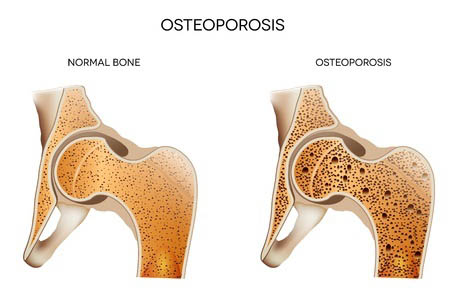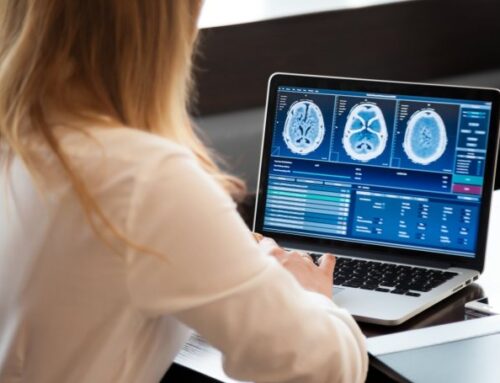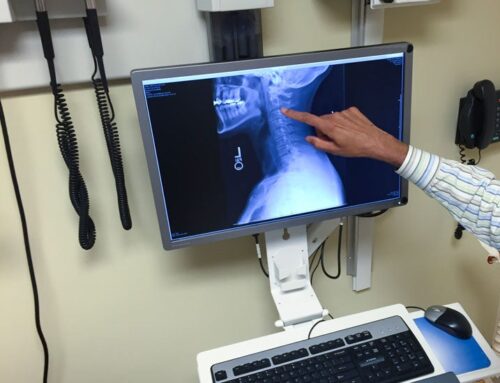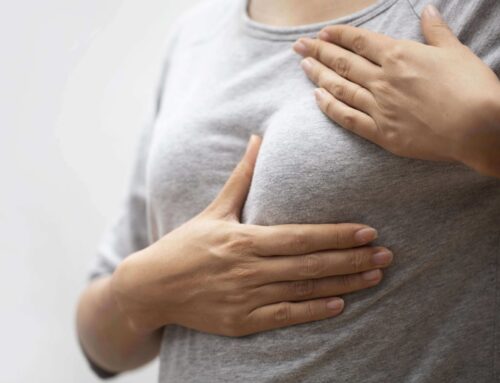Osteoporosis is a bone disease that causes our bones to become weak and more likely to a fracture in a longer duration of time. It is also known as a “silent disease” because the bones become brittle without any symptoms. Fractures can happen in any bone, but osteoporosis-related fractures mostly occur in the spine, hip, and wrist. A bone is a living tissue that keeps on changing through a process called remodeling – older bones making way to build new bones. When people reach their 40s, the peak of their bone density slowly starts to decrease. At this age in life, it becomes crucial to know the importance of bone health.
Bone is living tissue. To keep bones strong, your body breaks down old bone and replaces it with new bone tissue. Sometime around age 30, bone mass stops increasing, and the goal for bone health is to keep as much bone as possible for as long as you can. As people enter their 40s and 50s, more bone may be broken down than is replaced.
A close look at the inside of bone shows something like a honeycomb. When you have osteoporosis, the spaces in this honeycomb grow larger, and the bone that forms the honeycomb gets smaller. The outer shell of your bones also gets thinner. All of this makes your bones weaker.
Bone loss before osteoporosis (osteopenia)
The stage before osteoporosis is called osteopenia. This is when a bone density scan shows you have lower bone density than the average for your age, but not low enough to be classed as osteoporosis.
Osteopenia does not always lead to osteoporosis. It depends on many factors.
If you have osteopenia, there are steps you can take to keep your bones healthy and reduce your risk of developing osteoporosis.
Your doctor may also prescribe one of the bone-strengthening treatments that are given to people with osteoporosis, depending on how weak your bones are and your risk of breaking a bone.

Symptoms
During the early stages of bone loss, there are typically no symptoms. The first symptom of osteoporosis is the fracture or breaking of bone because of a minor fall. Some of the other symptoms include:
- Stress fractures (or tiny cracks in a bone) that feel like joint or muscle pain
- Gradual height loss
- Back pain
- Shortness of breath (due to compressed disks)
- Change in posture
Who has osteoporosis?
Although osteoporosis can strike at any age, it is most common among older people, especially older women. Men also have this disease. White and Asian women are most likely to have osteoporosis. Other women at great risk include those who:
- Have a family history of broken bones or osteoporosis
- Have broken a bone after age 50
- Had surgery to remove their ovaries before their periods stopped
- Had early menopause
- Have not gotten enough calcium and/or vitamin D throughout their lives
- Had extended bed rest or were physically inactive
- Smoke (smokers may absorb less calcium from their diets)
- Take certain medications, including medicines for arthritis and asthma and some cancer drugs
- Used certain medicines for a long time
- Have a small body frame
The risk of osteoporosis grows as you get older. At the time of menopause, women may lose bone quickly for several years. After that, the loss slows down but continues. In men, the loss of bone mass is slower. But, by age 65 or 70, men and women are losing bone at the same rate.
Risk factors
Certain factors raises your risk of getting osteoporosis:
- Age – With age, our bones naturally become thinner and this increases the risk of getting osteoporosis
- Your sex – Being a woman raises your risk of developing osteoporosis
- Race – Caucasian and Asian women are at a higher risk
- Body weight – Thin people are at higher risk of developing osteoporosis
- Family history – If one of your parents has had a broken bone, especially a broken hip, you are at greater risk of developing osteoporosis
- Excessive alcohol consumption and smoking
- Dietary factors – It is more likely in people with low calcium and vitamin D intake
- Steroids and other medications – Oral or injected corticosteroid medications may hinder the bone-rebuilding process
- Medical conditions – Celiac disease, inflammatory bowel disease, kidney or liver diseases, cancer, and rheumatoid arthritis, can raise the risk of developing the disease
- Sedentary lifestyle – People who spend a lot of time sitting at a desk are more prone to osteoporosis
What is osteopenia?
Whether your doctor calls it osteopenia or low bone mass, consider it a warning. Bone loss has started, but you can still take action to keep your bones strong and maybe prevent osteoporosis later in life. That way you will be less likely to break a wrist, hip, or vertebrae (bone in your spine) when you are older.
Can my bones be tested?
For some people, the first sign of osteoporosis is to realize they are getting shorter or to break a bone easily. Don’t wait until that happens to see if you have it. You can have a bone density test to find out how strong your bones are.
The U.S. Preventive Services Task Force recommends that women aged 65 and older be screened (tested) for osteoporosis, as well as women under age 65 who are at increased risk for an osteoporosis-related fracture.
A bone mineral density test compares your bone density to the bones of an average healthy young adult. The test result, known as a T-score, tells you how strong your bones are, whether you have osteoporosis or osteopenia, and your risk for having a fracture.




